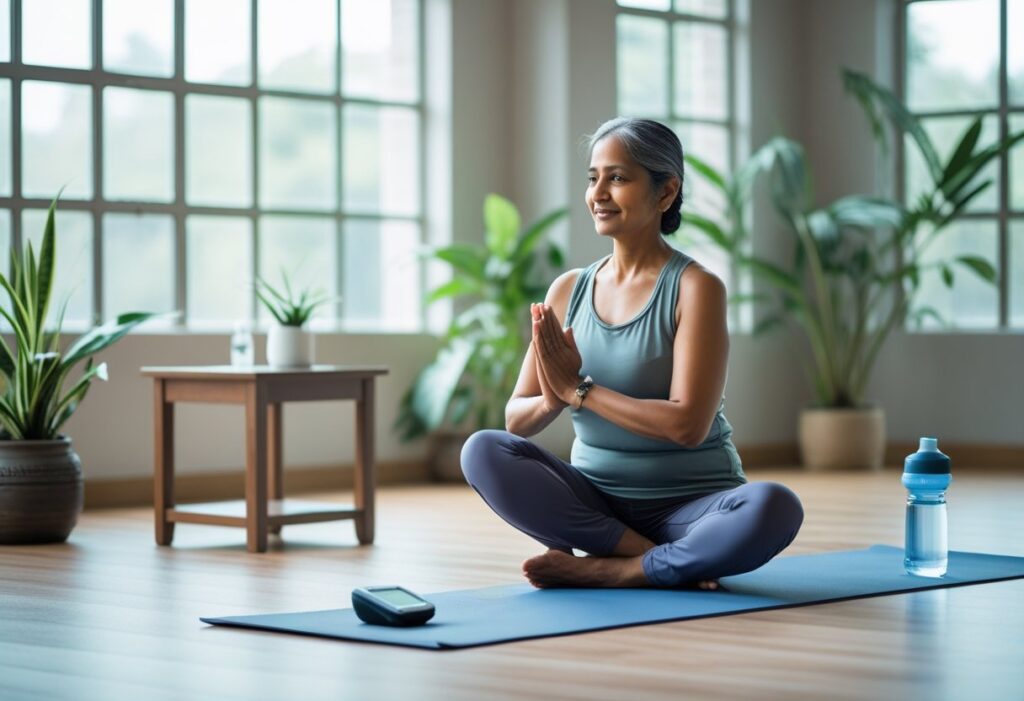Managing diabetes takes more than just watching what you eat. It’s a mix of diet, exercise, and honestly, finding ways to keep stress in check.
Lately, a lot of folks with diabetes have started practicing yoga. It’s gentle but surprisingly effective for helping control blood sugar and boosting overall health.
Yoga poses like Seated Forward Bend and Bow Pose may help manage diabetes when practiced regularly alongside traditional diabetes care.
Research suggests certain yoga exercises help lower stress hormones that push blood sugar up. Yoga can also make your body more sensitive to insulin, which is a big win for glucose control.
This guide dives into how yoga fits into diabetes care. I’ll walk you through which poses seem most helpful and how to add them to your daily routine.
You’ll find practical yoga routines made for people with diabetes. There are also some safety tips and ways to blend yoga with other lifestyle changes for better blood sugar control.
Key Takeaways
- exercise can help lower blood sugar and boost insulin sensitivity if you have diabetes.
- Poses like Mountain Pose, Bow Pose, and Legs-Up-the-Wall are especially useful for glucose management.
- Pairing yoga with medical care and healthy habits works best for managing diabetes.
How Yoga Supports Diabetes Management

Yoga works on diabetes in a few ways—some direct, some not-so-obvious. It helps your body process glucose better and can even boost pancreatic health through certain moves and breathing tricks.
Role of Yoga in Blood Sugar Control
Practicing yoga regularly helps your muscles soak up more glucose. Yoga helps improve glucose uptake by muscle cells during stretches and poses.
Yoga breathing techniques switch on your parasympathetic nervous system. That’s the “rest and digest” mode, which knocks down stress hormones that would otherwise spike your blood sugar.
Deep breathing lowers cortisol, a hormone that messes with glucose regulation. That’s a big deal if you’re trying to keep your numbers steady.
Key blood sugar benefits include:
- Lower fasting glucose
- Fewer blood sugar spikes after meals
- Better glucose tolerance all day
Studies show that yoga significantly reduces HbA1c, which is that three-month average blood sugar marker. Lower HbA1c means steadier long-term glucose.
Physical yoga poses get your muscles working so they use glucose more efficiently. The mix of movement and mindfulness really seems to change how your body handles sugar.
Impact on Insulin Sensitivity
Yoga helps your cells listen to insulin better, so the hormone can move glucose into tissues more effectively. The various postures during yoga practice help improve the sensitivity of β-cells to glucose, and those are the cells in your pancreas that make insulin.
With regular practice, people often see less insulin resistance. That means your body needs less insulin to keep blood sugar in check.
Insulin sensitivity improvements:
- Cells soak up more glucose
- Lower insulin needs
- Better hormone receptor function
Yoga’s stretches and twists boost blood flow to organs that handle glucose. That extra circulation helps insulin get where it needs to go.
Mind-body practices like yoga also seem to fight chronic inflammation, a sneaky culprit behind insulin resistance. Less inflammation means insulin can do its job better.
Influence on Pancreas Health
Certain yoga poses, especially gentle twists and compressions, can wake up your pancreas. These moves get the blood flowing and might help keep insulin production steady.
Yoga practice improves insulin secretion by supporting beta cell health. These cells release insulin whenever your blood sugar climbs.
Yoga’s stress-busting effects also protect those beta cells. Chronic stress can damage them, so dialing down stress hormones matters.
Pancreatic benefits include:
- Better beta cell function
- More consistent insulin output
- Protection from stress-related damage
Seated forward bends and gentle twists are extra good for your pancreas. They create just enough pressure to stimulate the organ without overdoing it.
Best Diabetes Yoga Exercises and Asanas

Certain yoga poses can help regulate blood sugar by targeting the pancreas and making your body more insulin-sensitive. Breathing techniques and relaxation methods add another layer by lowering stress hormones that mess with glucose.
Recommended Yoga Poses for Blood Glucose Balance
Some yoga asanas for diabetes focus on the pancreas and abdominal organs. These poses massage your insides and boost blood flow to the right spots.
Seated Forward Bend (Paschimottanasana) stretches your back and gently squeezes the belly. This pose for diabetes stimulates both the pancreas and liver. Just sit, extend your legs, and fold forward as far as feels right.
Bow Pose (Dhanurasana) is a deep backbend. Lying on your stomach, grab your ankles, then lift your chest and thighs. It’s a strong massage for your pancreas.
Legs-Up-the-Wall Pose is a gentle inversion. Lie on your back and rest your legs up against a wall. It improves circulation and helps chill out your stress response.
Mountain Pose (Tadasana) is the classic standing pose. It’s simple, but it helps lower blood sugar and sharpens your focus. Stand tall, engage your core, and breathe.
Breathing Exercises for Blood Sugar Regulation
Pranayama, or yogic breathing, directly affects your nervous system. Deep breathing brings on relaxation, which helps stabilize insulin and glucose metabolism.
Alternate Nostril Breathing (Nadi Shodhana) balances your nervous system by switching breath between nostrils. Use your thumb and ring finger to close off each side while you breathe slowly.
Deep Belly Breathing uses your diaphragm to calm stress hormones. Place one hand on your chest, one on your belly, and focus on moving the lower hand more as you breathe in and out.
4-7-8 Breathing is a simple pattern: inhale for 4, hold for 7, exhale for 8. This rhythm taps into your body’s relaxation response, which is great for blood sugar.
Structured yoga modules for diabetes often pair breath with movement. That combo ramps up the benefits from both sides.
Postures for Stimulating Digestion and Metabolism
Certain yoga poses work your digestive organs, helping your body process glucose and nutrients more efficiently.
Cat-Cow Pose (Marjariasana) moves your spine and massages your belly. Flow between arching and rounding your back on hands and knees to wake up digestion.
Cobra Pose (Bhujangasana) opens your chest and gently compresses the back. It’s a backbend that stimulates the pancreas, strengthens your spine, and even improves posture.
Plow Pose (Halasana) flips things upside down to send blood to your digestive organs. Lie on your back, then swing your legs overhead until your toes touch the floor behind you.
Sun Salutations (Surya Namaskar) string together a bunch of poses in a flowing sequence. This routine for diabetes includes forward folds, backbends, and standing moves that fire up your metabolism.
Relaxation Techniques for Stress Reduction
High stress means high cortisol, which can wreck your insulin function and spike blood sugar. Yoga’s relaxation methods are a direct antidote—helping your body let go of tension and stress.
Legs-Up-the-Wall Pose doubles as a circulation booster and a chill-out pose. The gentle inversion calms your nervous system and eases swelling in your legs.
Corpse Pose (Savasana) is all about stillness. Lie flat on your back and let your body absorb the benefits of your yoga session.
Progressive Muscle Relaxation means tensing and then relaxing muscles, one group at a time. Start at your toes and work all the way up, letting each part fully relax.
Yoga Nidra takes you to a place between sleeping and waking. This deep relaxation practice can slash stress hormones that mess with blood sugar.
Sample Yoga Routines for Diabetics

People with diabetes can follow yoga routines aimed at blood sugar control and stress relief. These range from gentle beginner moves to more active flows that boost insulin sensitivity.
Beginner-Friendly Yoga Sequences
If you’re new, start with simple poses designed for diabetes. A short 15-minute routine is a solid way to begin.
Morning Sequence:
- Child’s Pose – 2 minutes, just to settle in and relax
- Cat-Cow Stretch – 1 minute, warming up your spine
- Legs-Up-the-Wall – 5 minutes, great for circulation
- Seated Forward Bend – 3 minutes, gentle stretch for your back and legs
- Corpse Pose – 4 minutes, for deep relaxation at the end
This sequence helps keep stress hormones down—important, since they can push blood sugar up. You don’t need fancy gear, just a mat or even a carpeted floor.
If you have type 2 diabetes, hold each pose for the recommended time. You can do this routine every day, and it shouldn’t feel like a strain.
Focus on slow, deep breathing in every pose. It really helps kick your body into relaxation mode.
Advanced Yoga Flow for Glucose Control
If you’ve been practicing yoga for a while, you might want to try some more challenging yoga asanas for diabetes. These can really boost your blood sugar management.
Power Flow Sequence:
- Sun Salutations – Do 5 rounds to build heat.
- Warrior II – Hold for 1 minute on each side for strength.
- Triangle Pose – Stay for 45 seconds each side.
- Twisted Chair – 30 seconds each side to massage your organs.
- Bridge Pose – 1 minute to give your pancreas some love.
- Fish Pose – 1 minute to wake up your thyroid.
This 20-minute flow gets your heart pumping and your muscles working. That means your cells start using glucose more efficiently.
Advanced poses really fire up your muscles. The extra movement can make your body more sensitive to insulin.
Keep your breathing steady, even when the poses get tough. Quick, shallow breaths might actually spike your blood sugar—nobody wants that.
Incorporating Yoga Into Daily Life
Honestly, daily yoga makes the biggest difference for diabetes. Short, regular sessions beat long, rare ones every time.
Daily Schedule Options:
- Morning – 10 minutes of gentle stretches before breakfast.
- Afternoon – 5 minutes of breathwork during work breaks.
- Evening – 15 minutes of relaxing poses before dinner.
You don’t need a fancy studio to practice yoga for blood sugar control. Most poses just need a mat or even a towel.
It’s consistency that wins out, not how long you practice. Ten minutes a day does more for blood sugar than one marathon session a week.
Check your blood sugar before and after yoga. That way, you’ll know how different poses affect you.
Change up your routine based on your readings. Some people swear certain poses work better at different times of day—no harm in experimenting.
Safety Considerations and Precautions

If you have diabetes, you really need to take a few extra steps before diving into yoga. Monitoring blood sugar is non-negotiable, and sometimes, certain health issues mean you should skip yoga altogether.
Preparing for Yoga With Diabetes
Talk to your doctor before starting any yoga routine. It’s the best way to spot any risks based on your health and meds.
Test your blood glucose about 30 minutes before you practice. If it’s under 100 mg/dL, grab a snack with 15-20 grams of carbs first.
If you take insulin or diabetes meds, learn how exercise changes your blood sugar. Physical activity can lower glucose for up to a whole day after.
Bring these essentials:
- Blood glucose meter and strips
- Fast-acting carbs (think glucose tabs or juice)
- Water bottle
- Medical ID bracelet
- Emergency contacts
Let your yoga instructor know about your diabetes. That way, they can tweak poses if needed and keep an eye out for any warning signs.
Monitoring Blood Sugar Levels During Practice
Keep an eye on your blood sugar during yoga. If you feel dizzy, shaky, or just off, stop right away.
Watch out for these low blood sugar signs:
- Sweating more than usual
- Trembling or feeling weak
- Heart pounding
- Trouble focusing
If you notice those symptoms, test your blood sugar immediately. Anything below 70 mg/dL means you need 15 grams of fast-acting carbs—right away.
If your session lasts over 60 minutes, check your blood sugar midway. This is even more important if you’re on insulin or meds that lower glucose.
Skip hot yoga if you can. Heat messes with blood sugar and ups your risk of dehydration.
Contraindications and When to Avoid Yoga
Some health issues make yoga a no-go for people with diabetes. If you’ve got serious complications, avoid certain poses or modify your practice.
Skip yoga entirely if:
- Your blood glucose is over 300 mg/dL
- You have ketones in your urine
- You have active diabetic retinopathy
- You recently had a stroke or heart attack
If you have diabetic neuropathy, stay away from balance poses that could make you fall. Numb feet make balancing tricky.
High blood pressure? Avoid headstands or other inverted poses—they can spike your blood pressure dangerously.
If your diabetes meds just changed, hold off on new exercise routines. Let your blood sugar stabilize first.
Feeling sick or fighting an infection? It’s best to skip yoga, since blood glucose gets harder to control during illness.
Integrating Yoga With Other Lifestyle Approaches
Yoga works best when you pair it with your meds and a healthy diet. Adding other types of exercise can make diabetes management a lot more effective.
Combining Yoga With Medication and Diet
Keep taking your prescribed diabetes meds—yoga isn’t a substitute. Yoga’s a great add-on, but it’s not a replacement for medical treatment.
Regular yoga can help your body respond better to meds. The breathing and movement may even lower insulin resistance a bit over time.
Diet really matters alongside yoga. You might notice yoga makes you more mindful of what and how you eat. That self-awareness can lead to better food choices.
Eat balanced meals before yoga. Practicing on an empty stomach could drop your blood sugar too low. A small snack 30 minutes before practice usually helps keep things steady.
| Timing | Food Recommendation |
|---|---|
| 2-3 hours before | Full meal |
| 30-60 minutes before | Small snack |
| After practice | Balanced meal within 2 hours |
Benefits of Other Exercises for Diabetics
Yoga pairs well with other exercise. People with diabetes often find exercise tough because of weight or joint issues, but yoga can make their bodies more ready for movement.
Walking after yoga is a great combo. Just 10 minutes can help lower blood sugar. The gentle movement lets muscles soak up glucose.
Strength training twice a week builds muscle, which helps your body manage glucose and lowers insulin resistance. Yoga keeps you flexible, so strength work feels safer and more doable.
Swimming’s another winner—it’s low-impact, and the water takes the pressure off your joints. Try using yoga breathing while you swim for extra benefit.
Light cycling or a stationary bike gives you gentle cardio. Start with 10-15 minutes and add more time as you get stronger.
Frequently Asked Questions
People with diabetes always have a bunch of questions about yoga. Which poses work best? How do you stay safe? Let’s tackle a few of the big ones.
What are the best yoga poses for managing type 2 diabetes?
Several yoga asanas can help manage diabetes by improving insulin sensitivity and blood sugar. Sun Salutations (Surya Namaskar) give your body a full workout and get lots of systems moving.
Tree Pose (Vrikshasana) builds balance and focus, and it gently works your core. Plus, it’s great for stress—which, let’s be honest, can really mess with blood sugar.
Half Lord of the Fishes Pose (Ardha Matsyendrasana) uses twists to target the pancreas. These poses help with stress and pancreas stimulation.
Child’s Pose and Legs-Up-the-Wall help your body relax. When you calm down, cortisol drops, and insulin works better.
Can you provide a routine of yoga exercises recommended for type 1 diabetes patients?
If you have type 1 diabetes, start slow. Begin with gentle warm-ups, then move into more active poses. Mix in breathwork, standing poses, and some relaxation at the end.
Try 5 minutes of deep breathing (pranayama) to settle in. Then, do Sun Salutations at a moderate pace for 10-15 minutes.
Add standing poses like Warrior I and Triangle for 10 minutes. These build strength and help with steady blood sugar.
Wrap up with 10 minutes of restorative poses, like Supported Fish and Savasana. This combo can help regulate blood sugar and boost energy.
Check your blood sugar before and after to see how you respond. Adjust the intensity based on your numbers and how you feel.
How does practicing yoga impact blood sugar levels in diabetics?
Yoga can help rejuvenate pancreatic cells and improve how your body uses glucose. Over time, regular practice tends to lead to better blood sugar control.
Physical poses make your muscles use more glucose, both during and after practice. That effect can stick around for hours, helping keep your blood sugar steady.
Yoga’s stress-busting powers lower cortisol, which is huge. High cortisol messes with insulin, so less stress means better sugar control.
Yoga also boosts insulin sensitivity by increasing blood flow to your muscles and organs. Better circulation means your cells respond faster to insulin.
Deep breathing turns on your parasympathetic nervous system. That relaxation helps your body process glucose more efficiently—pretty cool, right?
What are some yoga asanas that can help in reducing diabetes-related complications?
Forward bends like Seated Forward Fold get blood moving in your legs and feet. That extra circulation can help keep diabetic neuropathy and foot issues at bay.
Inversions, for example Legs-Up-the-Wall Pose, really boost circulation everywhere. I find these poses help with swelling and give the heart a little support, too.
Twisting poses such as Bharadvajasana give your organs a gentle massage. They also seem to help digestion, which is a big deal for stable blood sugar.
Heart-opening poses like Camel Pose expand your lungs and get more blood flowing. Good circulation and lung capacity matter a lot for managing diabetes, honestly.
Balancing poses build up your nervous system and help with body awareness. That means fewer falls—something you definitely want to avoid if you have diabetes.
Is there a specific duration of daily yoga practice that is beneficial for diabetes management?
Most folks with diabetes do well with 20-30 minutes of yoga a day. That gives you enough time for breathing, movement, and some relaxation, but it’s not overwhelming.
If you’re new, just start with 10-15 minutes and build up. Consistent daily practice provides better results than longer sessions done infrequently.
Morning yoga can help keep your blood sugar steady for the rest of the day. If you practice in the evening, you might find it’s better for winding down and sleeping well.
Try breaking it up if you’re busy or just not feeling a long session. Maybe do 10 minutes of breathing in the morning, then 15 minutes of gentle stretches before bed.
Honestly, just pay attention to how your body reacts and tweak the duration as needed. Some days, you’ll want to go easy—listen to your energy and your blood sugar.
Where can I find a detailed yoga guide suitable for diabetes, preferably in PDF format?
Plenty of yoga schools and diabetes organizations put out downloadable guides just for diabetes management. These guides usually walk you through poses, offer modifications, and throw in some safety tips.
If you search for guides from certified yoga therapy programs, you’ll find ones that focus on medical conditions like diabetes. Most of these materials get checked by healthcare professionals, which feels reassuring.
Some diabetes education centers toss yoga resources into their management programs. It’s worth reaching out to local diabetes support groups—sometimes they know about the best, most trustworthy guides.
Online yoga platforms sometimes have specialized sequences, and you can usually grab the instructions as a PDF. Try to pick programs made by yoga therapists who actually know diabetes inside and out.
Before jumping in, make sure the guide says to talk to your healthcare provider first. The better resources really stress how important medical supervision is for folks with diabetes.



